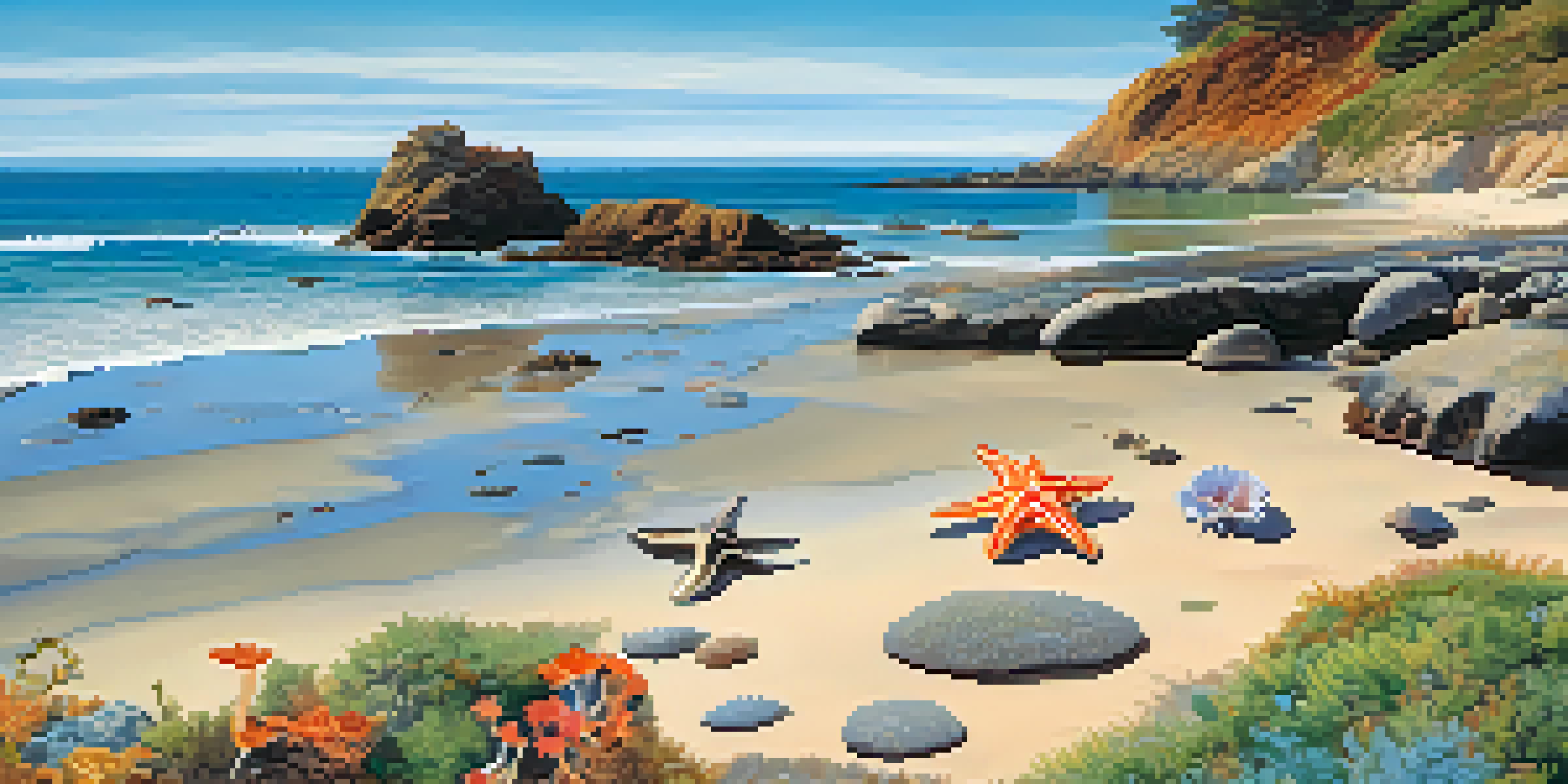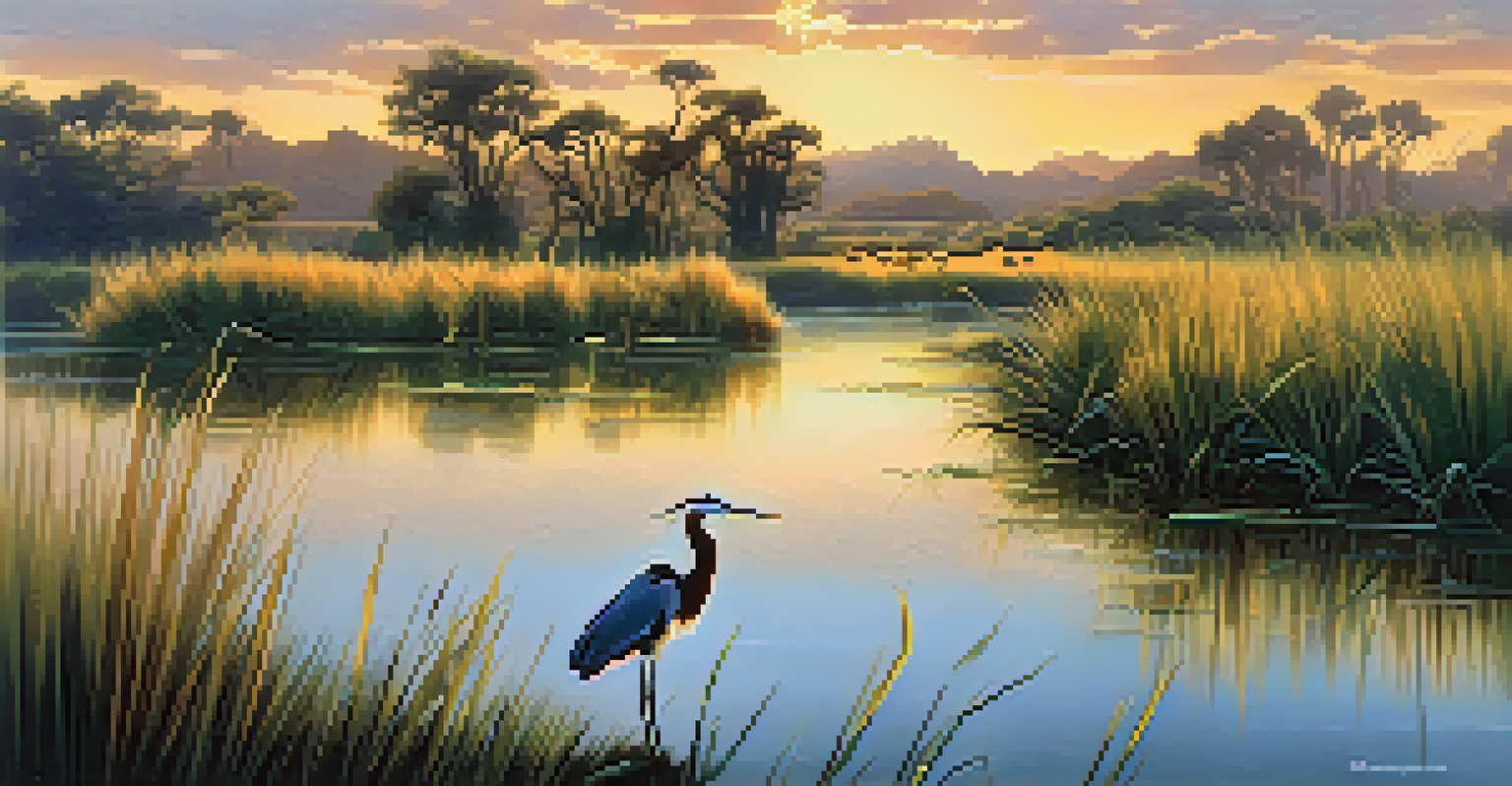San Diego's Coastal Ecosystems: A Biodiversity Hotspot

Overview of San Diego's Coastal Ecosystems
San Diego's coastal ecosystems are a vibrant tapestry of life, ranging from sandy beaches to rocky shores and vibrant tide pools. These areas serve as crucial habitats for countless marine species and offer a glimpse into the intricate web of life that thrives along the Pacific coast. With more than 70 miles of coastline, San Diego is home to diverse ecosystems that support both terrestrial and marine biodiversity.
The sea, once it casts its spell, holds one in its net of wonder forever.
The region's unique geography, combined with its Mediterranean climate, provides an ideal setting for various plant and animal species to flourish. From the surf-swept beaches to the estuaries and wetlands, each ecosystem plays a vital role in maintaining environmental balance. This diversity not only enriches the local environment but also enhances the quality of life for residents and visitors alike.
Understanding these ecosystems is essential for conservation efforts and sustainable practices. By appreciating the beauty and importance of these coastal areas, we can work together to protect and preserve them for future generations.
The Rich Marine Life of San Diego
San Diego's coastal waters are teeming with marine life, making it a hotspot for biodiversity. From dolphins and sea lions to an array of colorful fish, the ocean is alive with activity. One of the most remarkable features of this region is the presence of kelp forests, which provide habitats for numerous species and serve as vital breeding grounds for fish.

These underwater forests are not only breathtaking to explore but also play a crucial role in the marine ecosystem. They provide shelter and food for a variety of organisms, including invertebrates and small fish, creating a thriving community. Moreover, the kelp forests help to absorb carbon dioxide, making them essential in combating climate change.
Biodiversity in Coastal Ecosystems
San Diego's coastal ecosystems support a rich diversity of marine and terrestrial life, crucial for environmental balance.
In addition to kelp forests, the rocky reefs and sandy bottoms of San Diego's coast host a diverse range of species. Each organism, from the smallest sea urchin to the largest whale, contributes to the intricate balance of the marine ecosystem.
Tide Pools: Nature's Living Exhibits
Tide pools are one of the most fascinating features of San Diego's coastal ecosystems. These natural aquariums are formed in rocky areas where ocean water collects at low tide, creating unique habitats for various marine creatures. Exploring tide pools is like stepping into a world of wonder, where you can find starfish, anemones, crabs, and even the occasional octopus.
In every outthrust headland, in every curving beach, in every grain of sand, there is the story of the earth.
These miniature ecosystems are not only mesmerizing but also serve as vital research sites for scientists studying marine biology and ecology. The organisms that inhabit these pools have adapted to survive in a challenging environment, showcasing nature's resilience and ingenuity. Observing these adaptations helps us understand the importance of preserving such habitats against pollution and climate change.
Visiting tide pools can be an educational experience for families and nature enthusiasts alike. By respecting these delicate ecosystems and following guidelines to minimize human impact, we can ensure that future generations will also enjoy the beauty of tide pooling.
Wetlands: The Unsung Heroes of Biodiversity
Wetlands, often overlooked in coastal conversations, play a pivotal role in San Diego's biodiversity. These areas serve as critical habitats for birds, fish, and other wildlife, providing food and shelter while acting as natural filters for water. The marshes and estuaries along the coast are bustling with life, especially during migration seasons when various bird species flock to the region.
Moreover, wetlands help protect coastal areas from erosion and flooding by absorbing excess rainwater and acting as a buffer against storm surges. They also help improve water quality by trapping pollutants and sediments, making them essential for maintaining the health of both marine and terrestrial ecosystems. The loss of wetlands could have far-reaching effects on the entire coastal ecosystem.
Threats Facing Coastal Habitats
Urban development, pollution, and climate change significantly threaten the fragile ecosystems along San Diego's coast.
Conservation efforts aimed at restoring and protecting these vital areas are crucial for sustaining biodiversity. By raising awareness about the importance of wetlands, we can encourage community involvement in preservation initiatives, ensuring that these natural treasures remain intact.
Threats to San Diego's Coastal Ecosystems
Despite their beauty and importance, San Diego's coastal ecosystems face numerous threats. Urban development, pollution, and climate change pose significant challenges to these fragile environments. As cities expand, natural habitats are often replaced with concrete, reducing the space available for wildlife and disrupting the delicate balance of local ecosystems.
Pollution, particularly from runoff and plastic waste, further jeopardizes marine life. Many species are affected by ingesting harmful substances or becoming entangled in debris. Additionally, climate change is leading to rising sea levels and ocean acidification, both of which threaten the integrity of coastal ecosystems and the species that depend on them.
Addressing these issues requires collective action from individuals, communities, and policy-makers. By advocating for sustainable practices and supporting local conservation efforts, we can help safeguard San Diego's coastal ecosystems for generations to come.
Conservation Efforts in San Diego
Many organizations and initiatives are dedicated to protecting San Diego's coastal ecosystems. Local conservation groups work tirelessly to restore habitats, monitor wildlife populations, and educate the public about the importance of biodiversity. These efforts play a crucial role in ensuring that the rich marine and terrestrial life of the region continues to thrive.
One notable project is the restoration of coastal wetlands, which aims to re-establish natural habitats that have been lost to development. These initiatives not only help wildlife but also enhance the resilience of coastal areas against climate change. Community involvement is vital in these efforts, as volunteers often participate in clean-up events and habitat restoration projects.
Importance of Conservation Efforts
Local organizations are actively working to restore habitats and educate the public, highlighting the need for community involvement in conservation.
Public awareness campaigns also play a significant role in conservation. By educating residents and visitors about the value of these ecosystems and encouraging sustainable practices, we can foster a culture of environmental stewardship in San Diego.
How You Can Help Protect Coastal Ecosystems
Everyone can play a role in protecting San Diego's coastal ecosystems, even with small actions. Simple steps like reducing plastic use, participating in beach clean-ups, and supporting local conservation efforts can make a significant impact. Every piece of litter picked up or plastic bag avoided contributes to a healthier environment for marine life.
Additionally, educating yourself and others about the importance of biodiversity can create a ripple effect. Sharing knowledge about local ecosystems and conservation issues can inspire friends and family to get involved. Remember, awareness is the first step toward making a difference.

Lastly, consider supporting local organizations that focus on conservation and sustainability. Whether through donations, volunteering, or simply spreading the word, your contributions can help protect the stunning coastal ecosystems that make San Diego a biodiversity hotspot.